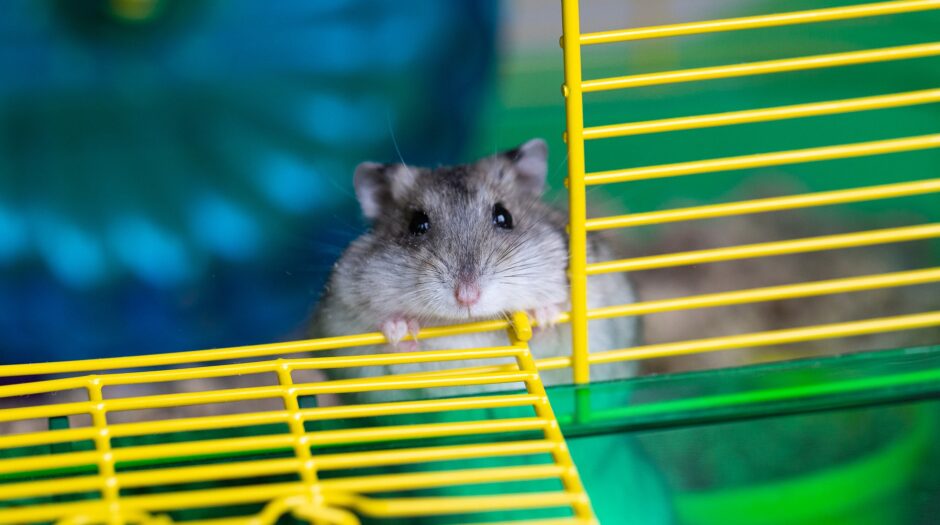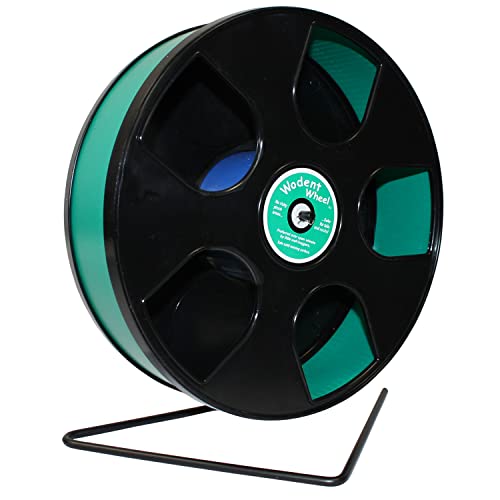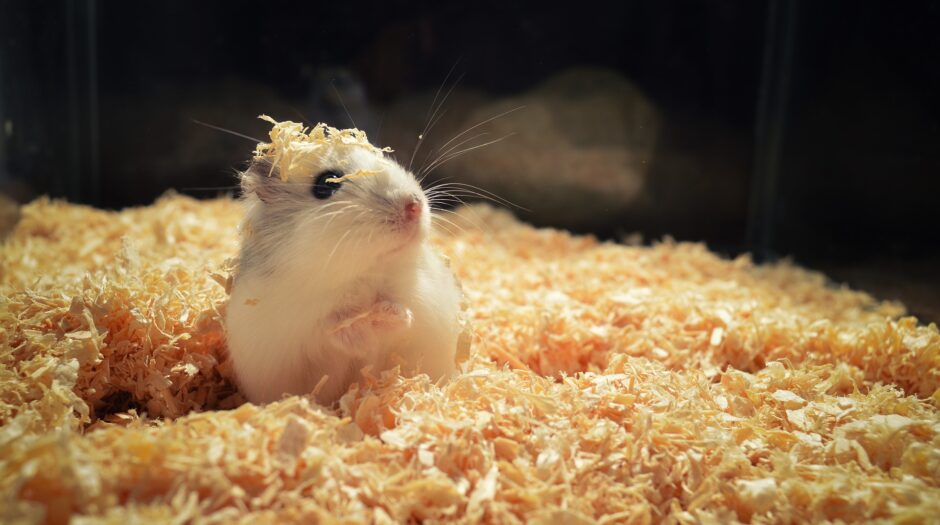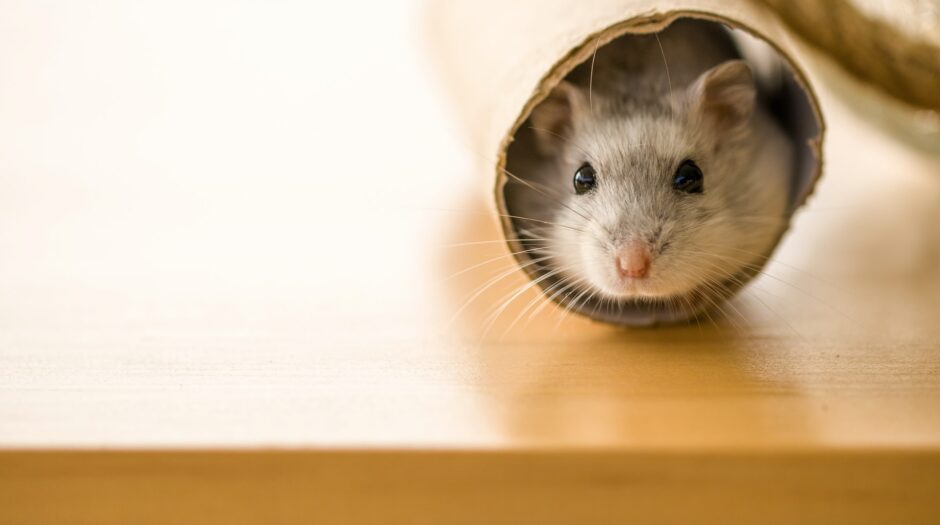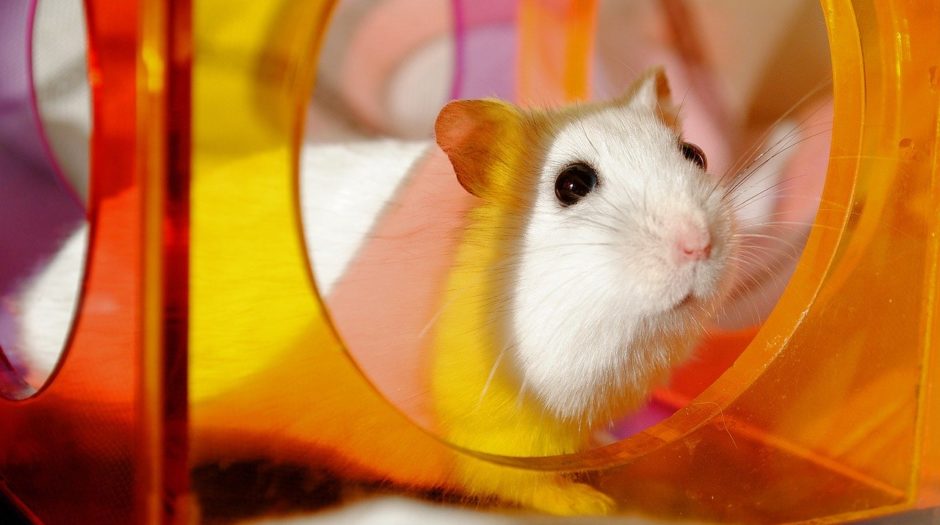Hamster Cages – Information, Size, and Q&As
Have you ever wondered why hamsters need such large cages and why pet cage companies make such small enclosures? –Or maybe you’ve wondered what counts as floor space.
Keep on reading to find out!
Please note: Amazon is one of the few places still shipping during COVID-19. We offer the best reviewed products from our Amazon Affiliate links in case you’d like to buy one. There is no cost to you and it helps keep the lights on around here (thanks!).

History and Origins
Despite being kept as pets, our domesticated hamsters are still very similar to their ancestors. Unlike dogs and cats who have been domesticated for thousands and thousands of years, hamsters have actually only been domesticated for a little under 100 years. This means that they still have many of the instincts that hamsters would have in the wild.
Hamsters actually started out in laboratories, where they would test them for various different things. In 1930, hamsters were taken into a lab for a behavioural study in Aleppo, Syria. These lab workers found that these animals were quite friendly, and therefore decided to take a few home. These were probably the first hamsters to be kept as a pets. By about 1946, hamsters became very popular pets in the US.
What is the Minimum Cage Size for A Hamster?
Currently the bare minimum amount of floor space needed for a hamster (in the USA) is about 450 sq inches. (it varies depending on the country and organization)
That being said, it is always better to go bigger if possible. This bare minimum is NOT just perfect number of floor space that ensures the happiness of your pet, which is why people recommend to go bigger. A bare minimum simply means that the number is the smallest you can go without being inhumane.
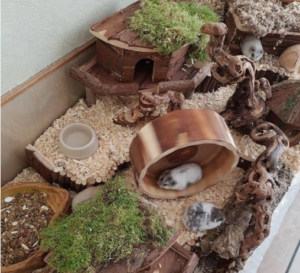
(Image Credit: Pinterest)
A hamster can still be unhappy in a larger cage. Remember, these little animals used to run for miles foraging for food in the night. This is also why having enrichment and a properly sized wheel is so important.
Recommended Cage Size:
Now that the bare minimum has been covered, what is a good recommendation for size? The recommended cage size is generally about 650 square inches. An experienced hamster owner may suggest a higher recommendation such as 800 sq inches. If you can go bigger, always go for it!
How to Measure Your Enclosure
What you need:
- A measuring tape (or some sort of measuring device)
- A calculator
That’s all you need! Figuring out how much floor space your hamster cage has is pretty easy…
- Put the measuring tape on the inside of the cage and first measure the width (depth) of the cage
- Repeat but measure the length of the cage
- Once you have the two numbers –> multiply them together using the calculator.
*Note: Check what units you’re using. If you measured using cm’s, convert it to inches to easily see your results in comparison to the minimum. If you’re using inches, you’ll easily be able to see if your enclosure meets the minimum and no conversions are necessary.
So…What Counts As Floor Space?
Floor space is referring to the amount of square inches (or square centimeters) that make up the bottom of your pets cage. As mentioned before, you can measure how much floor space you have but not everybody knows what really counts as floor space. Below are a few common questions…
Do Levels Count As Floor Space?
No, they do not count as floor space. Many people believe that you can have an enclosure that’s under the minimum and add a level to reach the bare minimum amount of space. For example, somebody might decide to buy a 300 sq inch cage and just add a level that contains 150 sq inches to meet the minimum. Unfortunately though, the 150 sq inch level doesn’t actually count towards the total floor space.
That being said, levels can still be a great source of enrichment so they are worth adding if you are interested. Just ensure that the bottom of your enclosure meats the bare minimum.
Can I Connect Several Small Cages Together To Add Floor Space?
While having multiple small cages is much better than only having one, it’s not the same as one big enclosure. The big enclosure has uninterrupted floor space, meaning the hamster can easily walk around without having to crawl through tubes to get to the next section of the cage.
Depending on the cage, it can count as floor space. However, you will need to make sure that at least one of the enclosures meets the bare minimum size requirements.
Why Do Hamsters Need a LARGE Enclosure?
As mentioned previously, hamsters in the wild used to run for miles during the night foraging for food, getting their energy out, and searching for nesting materials. They need a big enclosure so that they can still engage in their natural instincts that they would have in the wild.
Even though a wheel in a necessity, your hamster should still be able to burn some energy around their cage and get the proper enrichment they need from the things around them. The kind of enrichment they can’t get from a small enclosure. These little pets are hyper active animals. They need the space to roam around and be comfortable.

The height of the enclosure can also be important for providing a good amount of bedding. Hamsters in the wild have been known to make burrows underground that go as deep as 31 inches. With the hamsters we keep as pets, the recommended amount of bedding is 5-6 inches or more. Your enclosure also has to be high enough to fit a proper sized wheel (8″ or bigger).
What effects do small enclosures have on hamsters
Small enclosures have been known to cause a lot of stress for the hamster. A study found that hamsters living in a smaller enclosure actually increased the hamster’s overall body temperature, which indicates that small cages can cause chronic stress.
Small enclosures also mean that you have to clean their cage more often (maybe even once a week), meaning more bedding and more money spent. Plus, regular full cleans of a cage can cause more stress to your hamster because you’re regularly removing their scent. With a large enclosure, you only really have to clean their enclosure once a month with a bit spot cleaning every few days.
What if I Just Give My Hamster Lot’s of Playtime Instead of A Large Cage?
This would only work if you can supervise them all night. Hamsters are nocturnal animals. That means they are most active during the night, which is when they need the most amount space. Most people are probably not willing to stay up all night supervising their hamster, which is why it doesn’t make up for a small cage. Playtime for a hamster is still a good idea, it just can’t be a replacement for a large cage.
Providing a large enclosure for your hamster improves their quality of life and allows them to thrive. Large enclosures don’t have to be expensive, in fact you can even make one for pretty cheap. Some large enclosures can even cost the same amount of money as a small store bought one!
What Are Some Signs of Boredom/Stress
Bar biting and cage chewing are the most common signs of boredom and/or stress,which is often caused from too small of an enclosure or not a sufficient amount of enrichment. Here is an example of bar chewing…
Bar chewing isn’t something a hamster does to wear down their teeth, it is a repetitive behaviour that indicates a stressed hamster and can actually lead to injuries such as sores around the mouth or nose, misaligned teeth, or more serious issues.
Some other signs include…
- Monkey barring/Wall scaling (Climbing up the bars of their enclosure/using other object to try and escape)
- Cage pacing (when a hamster walks/runs back and forth against the walls of the enclosure)
- Lethargy
- Cage aggression (hamster is aggressive in the cage but act normally when you take them out)
If you notice you’re hamster doing these activities, it might be time for an upgrade. (or if you have a large enclosure and can’t upgrade you might want to add more enrichment)
Pet Store Cages – Reasons Behind Size and Design
Hamster cage companies often target children, they come up with cute eye catching designs to catch the attention of young kids to have their parents begging for their own pet hamster. But are these cages really allowing the hamster to thrive or is it all for our entertainment?
Companies started to create such small enclosures is because years ago, when hamsters first started appearing in homes manufacturers wanted to design them in a way that was compact and more convenient for the owner. Unfortunately they didn’t really consider what the pet needs to thrive and be happy.

These huge hamster companies would –and still do — advertise their insanely small cages by squeezing in eye catching words in such as “collect” or “connect” to encourage people to but more of their products. Cage companies now have also designed their enclosures to be colourful and fun looking to attract the attention of kids, who would begin to ask their parents to buy them.
Other Reasons Include…
- They want to make sure the enclosure is small enough to fit in a single household (means more people will buy hamsters and they get more money)
- Many people still consider hamsters to be novelty cheap pets that are almost “disposable” due to their small life-span. (which is why they target children a lot)
- There aren’t any “laws” regarding how large of an environment they need. (might partially be due to the fact that hamsters have been only domesticated for under 100 yrs)
- Small cages mean that more of them can be put on shelves.
- These huge cage companies that are creating these small enclosures often care more about the profit they make than the actual well-being of the pet.
Upgrading!
There are still a decent amount of appropriately sized enclosures out there that are above the minimum, we suggest that you check out our article called Best Cages Of 2021 – Reviews and Where to Buy and/or check out these enclosures on amazon:
If you measured you cage and realized that it is under the bare minimum, and are now you’re looking into upgrading then that is great!
That being said, hamsters can get stressed when moving to a new environment. To try and lower the stress, it’s recommended to move some of their current bedding to the new cage so that their scent is already there and to try and arrange the new cage in somewhat the same layout as their previous cage. If you notice that you’re hamster looks like they are nervous and/or unsettled, don’t immediately move them back to their old cage. Just give them time to become accustomed to their new home.
Another option would be to connect their old cage to their new one so that they can still have the comfort and feeling of safety but can also explore the new enclosure. After a couple weeks, you can detach the old cage if you want.
Thanks for reading our article! If your interested in reading more, maybe check out our article explaining How to Make A DIY Bin Cage For Your Hamster.

